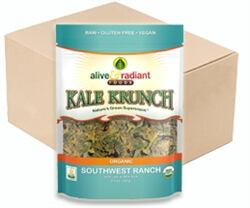“Demand has skyrocketed for kale seed which we now know was the result of a consumer interest movement based on the high nutrition density of kale and the market reaction with a substantial number of new retail products being offered containing kale,” said Jeff Trickett, sales and marketing director at leading US kale seed supplier Bejo Seeds Inc.
Kale provides an excellent source of vitamins A, C and K and is a good source of sulphur-containing phytonutrients. The fiber content of cruciferous kale binds bile acids and can help lower blood cholesterol levels and reduce the risk of heart disease, especially when kale is cooked instead of raw.
The total number of global introductions of food or drink products with kale as an ingredient more than trebled from 2007 to 2012, with 60% of the 2012 launches coming from the US alone, according to Innova Market Insights. According to data compiled for FoodNavigator-USA by research firm FoodEssentials, chips and snacks now account for the majority of kale-containing packaged foods and beverages, followed by packaged salads and vegetable mixes, vegetable-based and other juices, smoothies, baby food and health and recovery nutrition drinks. A quick comparison of health attributes for other vegetable-derived snacks compared to those made with kale found that “they are similar in terms of low fat content but kale has more vitamins and minerals,” FoodEssentials found.
Kale supply stable, Bejo says
While the initial surge in demand for kale seed in 2011 and 2012 took Bejo by surprise, it expects supply to be stable in the coming season, Trickett said.
“When this trend began to take off, we were also dealing with a competitive seed shortage at another supplier and therefore we misread the initial surge in demand for our seed as simply filling the void of our competitor’s short supply position,” he said. “This in turn created a slower reaction to increasing seed production sufficiently, so seed supplies have been somewhat tight."
Since then, because of reserves and Bejo’s response to production of seed, most of its growers have been able to obtain the seed they need to service their business, Trickett said, adding: “for this coming season we should be in very good shape for supply.”
Some manufacturers of packaged food and beverages containing kale, like top-three (per FoodEssentials data) kale chip maker Rhythm Foods, contract with multiple farms based on availability to avoid supply issues.
“At Rhythm Superfoods, we contract with three separate farmers in three different regions based on factors such as seasonality – so luckily it is not a problem," Janice Greenwald, vice president of brand marketing, told us. "We contract about 12 months out, so we don’t have any sort of challenges with our kale supply and same goes with our pricing. Since we have been working with farmers who have been in contact with seed growers for years and years, we have had really stable pricing and a stable kale supply.”

NY retailer, customers saw kale prices nearly double
On the retailer end, New York City grocery chain Westside Market NYC and its customers did feel the pinch of a kale shortage in recent months, as chief operating officer Ian Joskowitz told FoodNavigator-USA.
“We did see a shortage about three months ago that lasted five or six weeks,” Joskowitz said. “During that time the price of kale doubled [the wholesale price of a case went from $12 to $20] due to the increased demand. At this time, we don’t have a specific timeline, but unless the farmers can plant more, the demand will outweigh the supply, and a shortage will happen.”
However, Trickett said that Bejo’s seed pricing has remained stable, with only cost of living increases taking effect year to year—noting that retail pricing is more a function of products’ value.
“In the produce business supply and demand often affects market pricing levels,” he said. “I can’t comment on this specific example without more info but many of the new products coming out are ‘value-added’ and thus command a higher price than just basic bunched kale. I see no reason from the seed supply perspective that pricing will be significantly affected...pricing at retail is more a function of the value of the products being offered in terms of performance, ease of use, flavor, packaging, etc.”
Collards: the next kale?
For the time being, Trickett thinks demand for kale will remain strong, though likely not at the pace it has in the past. “I personally believe the demand will continue due to nutrition focus, eating more fruits and veggies, etc., and will not go away quickly, but the rate of increase will certainly level off and won’t grow like it has over last couple years,” he said.
Joskowitz says a variety of greens can stand in for kale, including broccoli rabe, arugula, watercress, spinach Swiss chard and collard greens—and like any food trend, its days in the spotlight are numbered.
“Food trends, like kale, constantly come and go, so while I think it will always have a place in people’s kitchens, collard greens is what will be the next big leafy green gaining popularity. Collard greens has a similar nutritional value and in my opinion tastes better. As many people in the south can already attest to, collard greens can be prepared in a variety of ways, many similar to kale, making it an excellent substitute.”
Collard chips, anyone?
